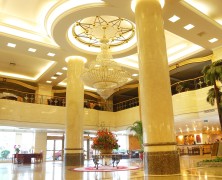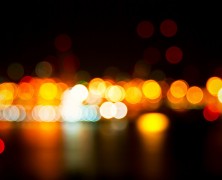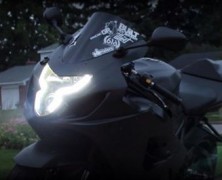Hotel guests are quick to develop their first impressions, and lighting plays a crucial role in this process. Even if a hotel’s interior design is well planned, ineffective lighting will throw a wrench in the entire presentation, leaving guests feeling uncomfortable and uninvited. Advancements in LED chip technology have allowed for a whole range of attractive, efficient, cost-saving options for hotels, hostels and guest houses worldwide. In this post we will explore some of these options for hotel lighting with LED strip lights in particular—focusing on lobbies, bedrooms, bathrooms, bars and restaurants, as well as pools and patios. Hotel Lobby Lighting Hotel lobby lighting strongly impacts a guest’s initial impression of a hotel, setting the stage for a positive experience throughout his or her stay. For luxury hotels or those seeking a sleek, modern feel, indirect cove lighting is an excellent choice. The technique involves running LED strip lights in ledges or recesses along the top edge of a wall or ceiling mounts, to shower indirect, evenly distributed light across the lobby. The technique is popular because of the high quality, even application of light it produces. It also conceals light fixtures, giving the lobby a more elegant, simplified feel. For lobby wall decorations and artwork, use high CRI LED strip lights as accent lighting to render colors as vividly as possible, providing a particularly stunning presentation. Hotel Guest Room Lighting Guests at your hotel will remember the atmosphere of the rooms, and lighting is sure to play a critical role. For hotel room lighting, as with hotel lobbies, indirect cove lighting is a great option because of the luxurious, elegant, and evenly distributed light it provides for your guests. Setting up LED remotes and dimmers in the room will give guests control of the lights’ temperature and...
Top 4 Reasons Why LED Lights Are Energy Efficient...
posted by Taran Volckhausen
LED lights are commonly discussed in the news today, for a variety of different reasons. Above all, there’s a great deal of emphasis on the fact that they’re considered “energy efficient”. But what does this mean exactly, and is it really the case? For a better understanding of this important topic, here are the top 4 reasons why LED lights are energy efficient, making them the best choice for residential, commercial and industrial applications. Lots of Light and Little Heat LEDs use only a fraction of the energy used by CFLs or incandescents to produce the same amount of light. For example, the standard 40 watt incandescent bulb produces 400 to 500 lumens (a measurement of light brightness). To produce this light with CFLs, you would need to use 8 to 12 watts. LEDs are simply more efficient; Flexfire LEDs’ UltraBright strip lights, for example, each foot of reel produces 400 to 670 lumens for just 4.4 to 7.5 watts. The reason for this is that the vast majority of energy that goes into LED lights is transferred into light. When properly engineered, many LED lights operate near 80% efficiency. That means 80% of the energy used becomes light. Incandescent bulbs on the other hand, work at just 20% efficiency, meaning that 80% of the energy used is transferred into heat—instead of light. The U.S. Energy Information Administration estimates that 17% of the total energy used by the United States’ commercial and residential sectors in 2012 went to lighting. That means switching to more efficient LEDs could have a dramatic impact on the country’s energy consumption. Longer Lasting When a light bulb goes dead, it costs energy to replace it. First, a factory must use energy to build its replacement. Then more energy is used...
Wearable Blue LED Light Therapy To Treat Psoriasis Vulgaris...
posted by Taran Volckhausen
Philips has announced the release of a wearable device that uses blue LED light to manage mild to moderate cases of psoriasis vulgaris. The device, which will be available through distributors this month in Germany, Netherlands and the U.K., is called Philips BlueControl and will offer an effective form of treatment for the skin condition without requiring medication. Psoriasis is a skin condition that effects 125 million people across the planet. Of those suffering from the condition, 80% have the most common form, psoriasis vulgaris. Also known as plaque psoriasis, the condition causes plaques on the skin in the form of red raised skin and flakey “scales” that arise when the skin cells die. Symptoms of the condition include itching, pain and cracking. Needless to say, the physical and psychological effects can be debilitating for those patients suffering from this disease. While the precise causes of psoriasis are unknown, it’s generally accepted that the condition arises following damage to the immune system, enzymes and other materials, which leads to uncontrollable growth of keratinocytes (immature skin cells that produce keratin, a tough protein found in nails, hair and skin) that triggers the skin flakes and inflammation as the body works to rid itself of the growth. Existing treatments to reduce the symptoms of the condition include topical applications, prescription drugs and UV phototheraphy—a treatment which taxes patients and medical services by requiring frequent visits to doctors’ offices. Looking for a better way to treat this incurable condition, researchers have found simple LED blue light treatment slows rapid cell division and can also reduce inflammation, which are the root causes of psoriasis vulgarsis. Conducting clinical trials in Germany, Philips worked with researchers at the University Hospital of Aachen to investigate the safety and efficacy of the Philips BlueControl device to manage...
How LED Lights Are Helping Address Climate Change...
posted by Taran Volckhausen
In New York City, 300,000 to 400,000 people recently took to the streets calling for action on climate change. These concerned world citizens would be pleased to note that as we shift away from inefficient incandescent bulbs, those who choose LED lights are helping address climate change by minimizing humanity’s environmental impact. Electricity production is the single largest contributor to CO2 emissions, accounting for 38% of U.S. emissions from 1990-2012. LEDs help us address climate change by lowering our electricity demand and therefore lowering our CO2 emissions. While installing LED strip lights in your kitchen won’t stop global warming, if you choose to make the investment in LEDs, you’re doing your part to slow its progress. Here are the top environmental reasons for choosing LEDs over other conventional lighting sources: Energy Efficiency High quality LED lights work at 80% efficiency. That means that 80% of the electricity used by an LED chip goes straight into producing light. Compare that to an incandescent bulb, which in many cases is just 20% efficient — 80% of the electricity used is transferred into heat instead of light. The U.S. Energy Information Administration estimates that in 2012, lighting constituted 17% of the total energy used by homes and businesses in the United States. Switching our lights over to LEDs, making them use electricity with 80% more efficiency, would have a dramatic impact on our CO2 emissions. There are other cases where LEDs will come in handy as well, such as LED refrigerator display lighting and poultry farming, where we can further lower energy demands since cool LED running temperatures require less artificial cooling. Furthermore, LEDs produce directional light, meaning light isn’t wasted in directions where it isn’t needed. Less Waste The typical lifespan of an incandescent bulb is 750 to 1,000 hours. CFLs,...
Customer Testimonial: DIY Motorcycle LED Mod...
posted by Taran Volckhausen
The latest in a long line of creative Flexfire LEDs customers, Nick Hopkins wanted to complete a DRL (“Daytime Running Lights”) modification on his 2004 Suzuki GSX-R motorcycle. After some research, he decided to use our UltraBright™ Design series Bright White LED strip lights for this distinctive DIY motorcycle LED mod. To install the lights, he started by cutting the LED strips to size. He then soldered the strips together and set them in a plastic fiberglass casing he made himself. As a finishing touch, he plastidipped the fiberglass casing in black to match the color of his bike. The 12v DC lights were then wired to the battery (which also runs at 12v DC) so they would come on every time Nick starts the engine. Daytime Running Lights are generally installed for safety reasons. Once installed, DRLs automatically switch on whenever the engine is engaged, increasing a rider’s visibility on the road. For a number of reasons, Flexfire LEDs strip lights are the best solution for motorcycle DRLs. First, they’re highly energy efficient, so they won’t tax your bike’s battery; also, they’re made of top quality components, meaning you can rely on them to function years into the future. Finally, they’re incredibly bright, making them a safer option than other low quality alternatives. Our high quality LED strip lights are the brightest on the market, built to the quality standard you’d expect and trust. They are rated to last for 50,000 hours of continual use, meaning they’re likely going to last for the entire lifetime of your bike. In Mr. Hopkins’s case, he was so pleased with the results that he shared a picture on our Facebook page. “Everyone can’t believe how bright they are,” he commented. We’d like to thank Nick for trusting Flexfire LEDs with his...










